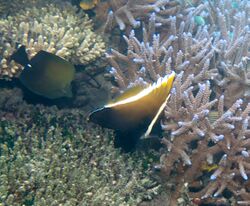Biology:Heniochus varius
| Heniochus varius | |
|---|---|

| |
| Scientific classification | |
| Domain: | Eukaryota |
| Kingdom: | Animalia |
| Phylum: | Chordata |
| Class: | Actinopterygii |
| Order: | Perciformes |
| Family: | Chaetodontidae |
| Genus: | Heniochus |
| Species: | H. varius
|
| Binomial name | |
| Heniochus varius (Cuvier, 1829)
| |
| Synonyms[2] | |
| |
Heniochus varius, the horned bannerfish or humphead bannerfish, is a species of marine ray-finned fish, a butterflyfish belonging to the family Chaetodontidae, native from the central Indo-Pacific area.
Description
The horned bannerfish is a small-sized fish that can reach a maximum length of 19 centimetres (7.5 in).[3] It has the typical deep-bodied and highly compressed body, typical of butterflyfishes.[4]
The horned bannerfish is told apart from its congeners by the adults having a pair of obvious horns on the forehead, just above the eyes and a prominent bump on the forehead.[2] The predominant colour on the body is brown to blackish broken by a thin white band behind the head and a second running from the spiny part of the dorsal fin to the caudal peduncle.[5] The two white stripes create a triangle of the base colour on the body.[6] The dorsal fin has 11 spines and 22-25 soft rays while the anal fin contains 3 spines and 17-18 soft rays.[2]
Distribution and habitat
The horned bannerfish is widespread throughout the tropical and subtropical waters of the central Indo-Pacific from Indonesia to Polynesia and from south Japan to New-Caledonia.[1][3]
It inhabits areas rich in coral in shallow lagoons and external reef slopes from the surface to a depth of 30 meters.[7]
Biology
The horned bannerfish is a solitary fish but it can live in pairs or even in small groups.[8] Its diet is varied and consists of coral polyps and various benthic invertebrates.[3]
Taxonomy
Heniochus varius was first formally described as Taurichthys varius in 1829 by the French anatomist Georges Cuvier (1769-1832) with the type locality given as Ambon Island in Indonesia.[9]
Conservation status
In some geographic areas, the horned bannerfish is occasionally harvested for the aquarium trade, however the species does not currently appear threatened is listed as Least Concern (LC) by the IUCN.[1]
References
- ↑ 1.0 1.1 1.2 Rocha, L.A.; Allen, G.R.; Myers, R.F.; Pratchett, M. (2010). "Heniochus varius". IUCN Red List of Threatened Species 2010: e.T165652A6081573. doi:10.2305/IUCN.UK.2010-4.RLTS.T165652A6081573.en. https://www.iucnredlist.org/species/165652/6081573. Retrieved 20 November 2021.
- ↑ 2.0 2.1 2.2 Froese, Rainer and Pauly, Daniel, eds. (2019). "Heniochus varius" in FishBase. December 2019 version.
- ↑ 3.0 3.1 3.2 Ewald Lieske; Richard Myers (2002). Coral reef fishes. Princeton University Press. ISBN 9780691089959.
- ↑ R. Pyle (2001). "CHAETODONTIDAE". in Kent E. Carpenter; Volker H. Niem. FAO, Rome. http://www.fao.org/3/y0770e/y0770e43.pdf.
- ↑ Bray, D.J. (2019). "Heniochus varius". Fishes of Australia. Museums Victoria. https://fishesofaustralia.net.au/home/species/428#summary. Retrieved 26 November 2020.
- ↑ "Heniochus varius". ReefLifeSurvey. https://www.reeflifesurvey.com/species/heniochus-varius/. Retrieved 26 November 2020.
- ↑ Allen, G.R. and M.V. Erdmann, 2012. Reef fishes of the East Indies. Perth, Australia: University of Hawai'i Press, Volumes I-III. Tropical Reef Research.
- ↑ Rudie Kuiter, “Chaetodontidae & Microcanthidae”, Aquatic Photographics, 2004, ISBN:0953909735
- ↑ Eschmeyer, William N.; Fricke, Ron; van der Laan, Richard, eds. "Species in the genus Heniochus". California Academy of Sciences. http://researcharchive.calacademy.org/research/ichthyology/catalog/fishcatget.asp?tbl=species&genus=Heniochus.
External links
- Photos of Heniochus varius on Sealife Collection
Wikidata ☰ Q1021923 entry
 |


